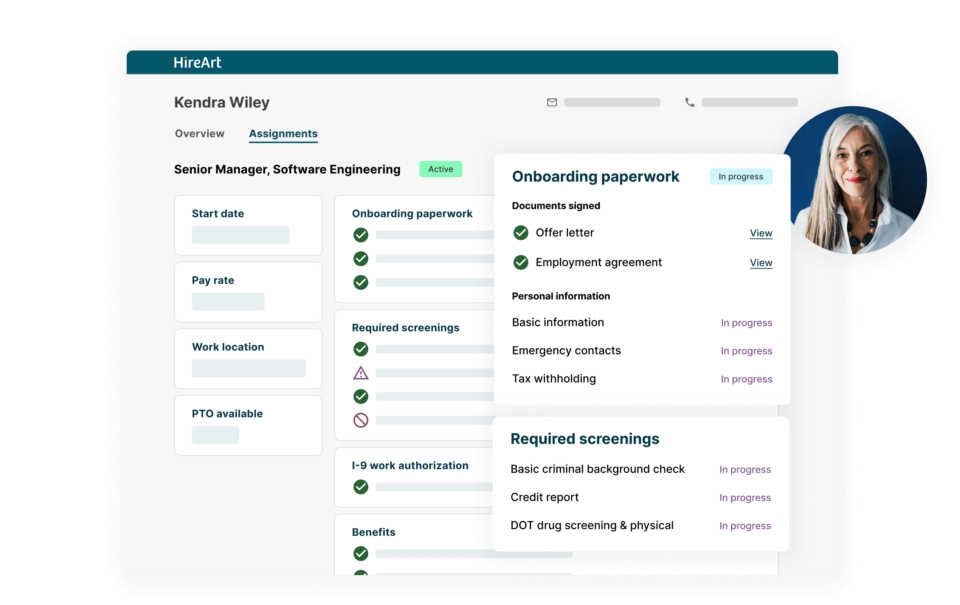HireArtwhich TechCrunch previously described as a “resume-killing” jobs marketplace, announced today that it raised $26.25 million in a Series B financing round led by Three Fish Capital with participation from over a “half dozen” angel investors. CEO Nick Sedlet said that the cash will be put toward product development and more than doubling HireArt’s 82-person headcount within the next year.
HireArt was originally founded in 2012 as an “assessment company” — the startup sourced and screened job candidates for companies much like a temp agency. But the co-founders — Dain Lewis, Eleonora Sharef and Sedlet — discovered that many of HireArt’s clients were hiring its people by putting them on the payroll of staffing firms as contractors.
“It was an ‘aha’ moment for us — here was a market that wanted our sourcing product and had amazing unit economics,” Sedlet told TechCrunch in an email interview. “So in 2017, we ‘re-founded’ the company and launched our current model under which HireArt both sources and employs the workers on behalf of businesses.”
Prior to HireArt, Lewis was a senior business analyst at commercial real estate company General Growth Properties — since acquired by Brookfield Property Partners. Sharef was a business analyst at McKinsey, and Sedlet was a Goldman Sachs strategist.
Image Credits: HireArt
Companies often use staffing agencies to hire and employ workers who cannot be classified as independent contractors. Agencies focus on recruiting candidates, but — the way Sedlet tells it — they don’t pay much attention to the post-hire experience.
“As a staffing client, it’s difficult to manage basic workflows, like pulling a roster of workers, giving someone a bonus, or approving PTO. As a worker, the staffing industry only offers bare-bones benefits, makes basic administrative tasks difficult, and certainly provides little support like career growth and performance management,” Sedlet said. “We think that great software — coupled with caring support — solves these problems, by enabling self-serve functionality for businesses and workers, and providing an employment experience that’s worthy of the value that contractors bring to companies.”
With HireArt, a hiring manager can request workers to receive a curated shortlist of candidates and schedule interviews before making any offers. Through the platform, managers can perform tasks like changing pay rates, approving expenses, and pulling reports.
“A company like Meta has tens of thousands of contractors. A typical HireArt client may have dozens or hundreds of contractors, employed through a handful of staffing agencies,” Sedlet explained.
Sedlet paints the staffing industry as a fragmented but massive opportunity, estimated to be worth close to $500 billion in the US alone. Tens of thousands of recruiting and staffing agencies compete for a slice of the pie, but the largest owns only around 7% of the market.
Because HireArt goes to market the way staffing agencies do, it’s often competing with them for new business. But HireArt doesn’t term them as rivals. On the contrary, President and CRO Chris Brower said HireArt partners with agencies to allow them to submit candidates to its clients’ open jobs and then employs those workers, sharing the revenue with the staffing partners.

Image Credits: HireArt
“This gives our clients access to a massive pool of talent, all employed through a single platform,” Brower told TechCrunch via email.
HireArt’s customers include the aforementioned Meta, Carta, Amazon-owned Zoox, and ride-hailing platform Via. Several of those customers have announced layoffs or reportedly planned layoffs as macroeconomic headwinds take their toll. But Sedlet expressed confidence that HireArt, while not currently profitable, will reach profitability by the end of 2023.
“Our last raise was just $2 million back in 2017 to fund our pivot. With that capital, we were able to grow 70% year-over-year and reach profitability with around 30 employees,” Sedlet said. “With this much larger fundraise, we expect to grow even more quickly.”
Certainly, some investors, like Three Fish Capital, see the long-term potential of new-age staffing, hiring and recruitment firms. And 2021 was a banner year for HR tech, with $16.8 billion invested in the worldwide category. In the first quarter of 2022, future-of-work companies attracted over $4.5 billion, setting the stage for another cash-rich year.
“HR tech has gotten dramatically better, with companies like Gusto and Rippling providing huge improvements in how companies and employees manage employment for the permanent workforce. The contract workforce, however, hasn’t seen a modern human resources information system (HRIS) yet,” Brower said. “HireArt makes managing [a] contract seamless workforce and provides an excellent employment experience to workers.”
